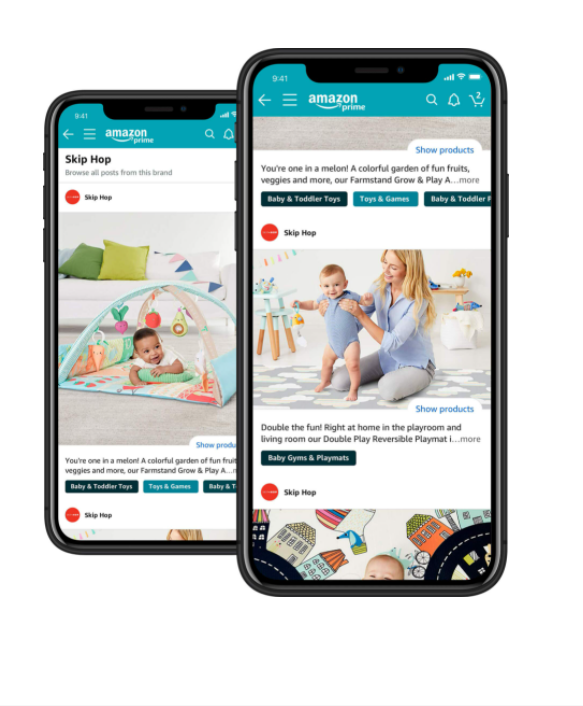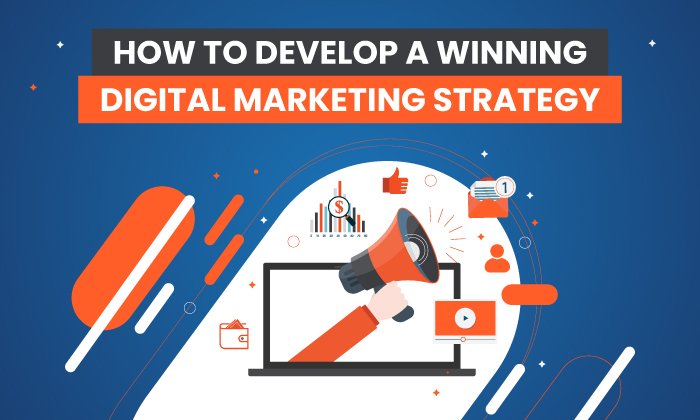Many brands are just chasing the latest digital marketing trend. When social media platform X becomes popular, they’re posting on it.
For every overnight success in the digital marketing world, there are dozens of brands quietly building robust, data-rich marketing digital marketing strategies. Committing to the process of growth demands intention and consistent focus.
You don’t just want to succeed this month or this year. You want to succeed indefinitely. That’s why today we’re going to take a look at how you can build a digital marketing strategy that promotes long-term, consistent growth.
Why Should You Have a Digital Marketing Strategy?
Having a well-defined digital marketing strategy provides you with some immediate perks. Right off the bat, it provides you with a certain degree of protection. Proper planning ensures that brands are spending resources wisely.
Wasting time and money on marketing campaigns is a common brand fear, but lacking critical information about your marketing intentions and decision-making process can be an absolute nightmare.
When you develop a digital marketing strategy, you’re able to test and confirm specific marketing data points. Let’s say your latest campaign is about appealing to a particular customer behavior.
Establishing a clear digital marketing strategy lets you stress-test your marketing assumptions, which becomes especially useful when you’re targeting certain audiences.
At the same time, you’re building a foundation for continued marketing growth with your digital marketing strategy. Imagine a scenario where a brand’s first marketing push underperforms. Without an established strategy, it can be impossible to know exactly what went wrong.
Did they focus on the wrong key performance indicators, or KPIs? Did they have unrealistic goals in the first place? Was there something wrong with their competitor analysis? These questions become much easier to answer when you already have a well-defined digital marketing strategy.
4 Steps to Develop Your Digital Marketing Strategy
If you’ve never developed a digital marketing strategy, the process can feel a bit intimidating. When building your marketing strategy, there are dozens of potential metrics and techniques you could choose to focus on.
For now, let’s prioritize two key elements: clarity and experimentation. To maximize clarity, we’re going to spend time defining our target audience and establishing clear goals. When it comes to experimentation, we’re going to focus on growth and the implementation of specific marketing tactics.
Over time, your digital marketing strategy will become more complex as it continues developing. The more data you collect, the more complex your strategy will need to be. That’s why establishing a strong foundation early on in the process is so crucial.
1. Research and Understand Your Audience
Before we dive into the deep end of digital marketing strategy, we need to spend some time unpacking the concept of target audiences.
Target audiences are defined by specific data points, like:
- gender
- age
- education
- purchasing power
- location
By targeting certain demographics, your ad budget is being spent as efficiently as possible.
Of course, this leads us into the most challenging aspect of audience targeting: properly defining your audience.
You’ll want to start by analyzing your market. Determine whether you’re operating in a well-established market or developing one. Is your industry mainstream? Who are your major competitors?
Once you’ve clearly defined your market, think about the type of customer you’re looking for. A good rule of thumb is to start with a general idea of your ideal customer, and use data points to further narrow your audience down.
For example, let’s say you’re selling high-quality hiking backpacks. You can start by determining that one of your target audiences will be made up of men that love hiking. However, by researching ages, locations, and income, you can develop a much clearer picture of your ideal customer.
A possible target audience for your product might be men, 25 to 35 years old, living in Colorado, with a monthly income of $4,000 to $6,000. Still, this is just the tip of the iceberg. If you want to truly understand your audience, you need to identify how they spend their time in the digital media landscape.
Find the most popular blogs in your industry, the e-commerce stores they shop at like REI, and the YouTube videos they watch. Keeping track of this info gives you insight into what they like to consume, which will make outreach and content creation significantly easier.
2. Set Digital Marketing Strategy Goals and KPIs
Over the years, I’ve noticed that when discussing digital marketing strategy, the concept of goal-setting is typically glossed over. This is a shame because a well-defined set of goals can empower your brand with some pretty useful perks.
Remember those two key elements we mentioned earlier, clarity and experimentation? Well, setting goals properly ensures that your digital marketing strategy is both easy to monitor and update.
OK, setting goals is important. The real question is how on earth should you be setting marketing goals?
When the average person thinks about setting goals, they tend to focus on qualitative goals. An example of a qualitative goal would be wanting to improve your brand image, or increase your brand’s position within your industry.
You can start to see the problem with these kinds of goals. Since qualitative goals are abstract, they’re notoriously difficult to measure.
I’ve found that these abstract concepts aren’t typically useful to the average brand’s digital marketing strategy. After all, if something’s difficult to measure, it’s also difficult to improve.
Instead, focus on quantitative goals. If this is getting a bit confusing, let’s try a little thought experiment.
Imagine we have two brands: Brand A and Brand B. Brand A wants to improve customer perception with their latest marketing campaign. They spend their ad budget on building content that paints their brand in a positive light and they promote their content on multiple channels.
While they manage to get plenty of traffic, they quickly realize there’s a massive issue. They haven’t learned anything concrete from this campaign. Brand A doesn’t know exactly why they received so much traffic, and they aren’t even sure how much of that traffic led to conversions. Without a focus on clarity or data collection, they walked away with no real path to growth.
Brand B had a different approach.
Instead of focusing on the abstract, they decided to find goals they could measure. Brand B didn’t just want to improve customer perception, they wanted to increase conversions on product X. Product X is responsible for 75 percent of their business, so maximizing this product’s conversion rate is a top priority for Brand B.
The goal is to improve their Product X conversion rate by five percent over the next six months. They aim to accomplish this by increasing social media post frequency, creating video ads, and writing a monthly email newsletter.
Make no mistake, Brand B started their goal-setting process by defining some abstract goals. The difference here is that Brand B went further and established tangible milestones for each abstract goal. Easy to measure, broken down into simple components to make experimentation possible.
If the goal is met, Brand B will have data showing the specific action responsible for the increase in conversions. If they don’t meet their goal, they’ll have clear information that shows which marketing components didn’t work properly. Either way, Brand B walks away with the information they need to make their next marketing campaign successful.
Establish clear, measurable goals, identify the KPIs that matter to your brand, and set goals that make long-term experimentation and growth possible.
3. Create Your Digital Marketing Strategy
Now that we’ve taken care of the basics, it’s time to actually build and implement a digital marketing strategy.
The biggest challenge here is determining which digital marketing channel to focus on. If this step stresses you out, you’re not alone. One of the reasons this decision can feel so intimidating is the fear of investing in a channel that won’t work.
Fortunately, our framework for digital marketing strategies minimizes that risk dramatically. By starting with small, hyper-focused campaigns, brands can track how effective a particular channel is without spending thousands of dollars.
Interested in paid social media ads? Set up a goal, implement a small marketing push, and determine how valuable Facebook ads are to your brand. Using that data, you can predict how effective future campaigns within that channel will be.
In fact, by using this approach for multiple channels, you’ll quickly develop a clear sense of which channels your audience responds to. Constantly test both marketing tactics and different target audiences to collect as many relevant data points as possible.
Within a year, you’ll have a collection of data points that are easy to interpret, and even easier to leverage into successful marketing campaigns.
As far as content creation itself is concerned, there are generally two schools of thought. Sometimes, your audience is looking to be entertained. If it’s brand appropriate and you feel confident in your content crafting abilities, fun content can be a powerful tool.
Maybe it’s a funny video ad, maybe it’s some memes on social media. It’s certainly not the right approach for everyone, but it’s certainly effective when used properly. Take a look at Old Spice and see how its unusual humor perfectly captures their brand voice.

Let’s say that you aren’t confident in your comedic timing, or your brand just doesn’t lend itself to absurdist internet humor. That’s where the second school of thought comes in. Educating your audience can be just as powerful as entertaining them.
To be clear, when we talk about educating your audience, that doesn’t mean educating them solely on your brand. No matter the industry, consumers have pain points that they need addressing. Typically, they’ll have industry-related pain points that you might not be a direct solution for.
Here’s an example. Let’s say you’re selling those hiking backpacks again. Could you stick to making content about hiking backpacks? Absolutely, but there’s so much more you can discuss!
If you’re selling to the hiking community, they have all sorts of questions about what kind of grills to use, tips for first-time hikers, what they should look for in a sleeping bag, etc. If you’re an expert in your field, you probably have an entire blog’s worth of content in your head right now!
A good rule of thumb is if you wish you knew about it when you first started, it’s going to be useful to someone. You don’t need a massive ad budget to connect with consumers. You just need to create marketing content that feels legitimately helpful. If you can do that, you can create truly impactful marketing campaigns.
4. Continue Improving
Growth, particularly long-term growth, is something that brands all over the world struggle with. It’s one thing to collect all those data points. Turning them into next quarter’s marketing campaign can quickly become a frustrating experience.
Here are just a handful of the issues that brands struggle with at the end of a marketing campaign.
- The brand doesn’t know which problems need fixing.
- The brand doesn’t fully understand their audience.
- The brand can’t see the value in their data.
- The brand has too much data and can’t make sense of it all.
While you can certainly turn to the professionals for help analyzing and improving, that’s not always possible if you’re operating with a shoe-string marketing budget.
Establishing clear, tangible goals and tracking your results makes this process significantly easier, but I’ve found that some brands struggle with the concept of long-term growth. Specifically, what growth looks like in the real world.
There’s no easy way to say this, so I’ll just say it: Growth is not always a straight line. Sometimes, you’ll invest in five marketing channels and only one of them will present you with a positive return on investment or ROI.
With each new expansion of your digital marketing strategy, you’ll identify components that work and components that don’t. Savvy brands understand this and commit themselves to the process of promoting long-term growth in their business. They’ll explore the latest social media platform. They’ll try the newest marketing channels.
This approach probably won’t lead to astronomical growth in two months, but the goal of a robust digital marketing strategy is to not stumble onto a marketing channel that delivers insane results. Why? Well, because sometimes those channels stop being effective.
Instead of looking for the marketing silver bullet, collect relevant, valuable data and slowly develop your long-term plan for sustainable growth.
Digital Marketing Strategy for E-Commerce Business Owners
When we think of e-commerce businesses, it’s easy to focus on the more technical elements of digital marketing. SEO, PPC, etc. Amazon, though, one of the world’s biggest e-commerce platforms, approaches things a bit differently.
Amazon actually has a robust social media marketing strategy, designed to inspire and engage with potential shoppers in unique, meaningful ways.
Social media marketing is about more than just paid ads and memes. For example, when your e-commerce brand interacts with customers on social media, the entire world can see how you handle both customer compliments and customer complaints.
Amazon is so committed to the social media experience that they’ve launched their own shopping social network feed. Amazon Posts allow customers to interact with brands via that brand’s feed on the Amazon app. These posts are product-related, and offer value to consumers in a familiar format.

By recognizing the power that social media interactions have, e-commerce sellers can identify unique ways to interact and connect with consumers.
Digital Marketing Strategy for Small Business Owners
Creating content that’s truly impactful is rarely easy. Even massive brands like Coke and Pepsi don’t always get it right. That’s why I’m always fascinated by the way Dollar Shave Club exploded onto the scene.
In their very first video ad, Dollar Shave Club makesa compelling case for their product while also providing some incredibly entertaining ad content. As a small business, your goal is to make an impact. The problem is that most small business owners think they need a massive ad budget to compete in their industry.
Let’s clear something up: You don’t need money to be memorable. You just need to understand your brand, your audience, and what makes your product special.
Digital Marketing Strategy for Marketers
Creating stale, uninspired content is a fear that every marketer has had to deal with. Once you’ve exhausted the usual list of content ideas for your industry, it can be difficult to identify content ideas that are both new and exciting. One of the ways that clever marketers overcome this issue is by promoting user-generated content or UGC.
UGC lets the average consumer interact with your brand in a unique way. More importantly, it can inspire a piece of content that you can share with your audience. The real trick is finding an action or activity that’s compelling enough that consumers actually want to participate.
One of the best examples of UGC in modern marketing is the Starbucks Cup Art challenge. Consumers absolutely love the Starbucks aesthetic, and having a chance to contribute to that aesthetic was a fun, exciting opportunity.

Customers were encouraged to design their own Starbucks designs, with Starbucks promoting their favorites and even integrating some of the designs permanently.
Identify what your customers love about your brand, and find a way to give them genuine impact on its future development.
FAQs About a Digital Marketing Strategy
How can I start digital marketing?
Start with the basic building blocks of digital marketing. Understand your audience and establish clear marketing goals. Start testing and keep experimenting until you find what works!
Is digital marketing easy?
Definitely not, but it’s far from impossible to figure out! Commit yourself to the learning process and eventually, you’ll have a digital marketing strategy that can support long-term growth.
Is coding required for digital marketing?
Absolutely not! Many of the techniques you’ll need to master can be essentially self-taught, with enough patience and the right direction.
What is a KPI?
KPIs or key performance indicators, are metrics brands that track to determine how effective their marketing is. Examples include: conversion rate, bounce rate, ROI, etc.
Digital Marketing Strategy Guide: Conclusion
At first glance, the sheer depth of digital marketing strategy can be intimidating. There are dozens of different marketing channels. Plenty of metrics to track. Frankly, there’s so much to unpack it’s no surprise some brands just outsource their marketing to agencies.
If you don’t have the budget for that, or you just like having full control of your marketing, you’ll need to commit to properly create a digital marketing strategy. Luckily, getting started can actually be pretty straightforward.
Take the time to understand your audience and make sure to establish tangible marketing goals. Test your assumptions frequently and experiment until you find the right approach. Commit to the process of long-term, sustainable growth by collecting relevant, valuable data and building a robust marketing strategy.
It might sound simple, but make no mistake. If you can successfully implement these steps into your next digital marketing strategy, you’ll be in a position to outshine your competitors and create some truly powerful marketing campaigns.
What marketing channel have you had the most success with?



